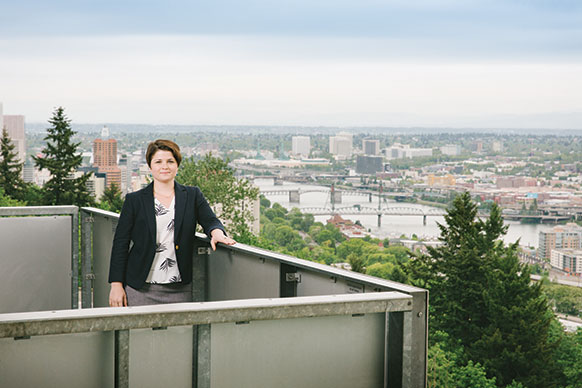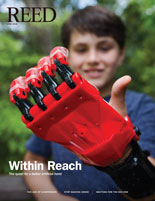
IRIS login | Reed College home Volume 95, No. 2: June 2016
Outplanning Catastrophe
 Photo by Erik Ursin
Photo by Erik Ursin
Emma Stocker ’07 gets ready for the Big One
By Kieran Hanrahan ’15
The lights go out at 8:22 PM Pacific Standard Time.
Inside OHSU’s sky tram, the passengers stumble as the tram lurches to a halt. The first thing they notice is that the darkness doesn’t wash upon the city gradually, block by block like in the movies, but arrives all at once, leaving Portland a tenuous spiderweb of light cast by the traffic still moving on the roads. The second thing they notice is the arc of the Milky Way rising over the darkened Willamette Valley. The view, beautiful but sinister, is the result of a cyber attack on the Pacific Northwest’s energy infrastructure. Within a half hour, failures cascade across the power grid, known as the Western Interconnection, that extends from Washington to New Mexico. Millions of people lose power, and with it, water.
It sounds like the plot of a science fiction thriller, but this scenario is one of several outlined by a government agency with a dull four-letter acronym in an annual report with its own dull five-letter acronym. Emma Stocker ’07 authored the report, known as the Threat and Hazard Identification and Risk Assessment (THIRA), while working for Portland’s Regional Disaster Preparedness Organization (RDPO) last year.
Stocker’s job as an emergency manager at Portland State University is to imagine the worst thing that could possibly happen—and then prepare for it.
The bulk of her work can be broken down into two parts. The first part, she calls “gap identification.” To identify gaps in an organization’s preparedness, she concocts worst-case scenarios (like the cyber-attack plot), coordinates with the relevant parties to create a best-case preparatory plan (100% infrastructure resilience to hacker infiltration), and then figures out what they need to get there from where they are now (redundancies that activate automatically in the event of primary system failure).
The second half of her work consists of preparing plans and procedures to use in case of a crisis. “When we’ve got an emergency situation on hand, because it’s broken our standard operating procedures, to take our normal operational solutions and try to apply that to this crisis, that, by definition, doesn’t work.” You can’t plan for every detail of a possible emergency, but having a clear procedure in place can prevent you from freezing up, she says. “A crisis situation is overwhelming, and it can paralyze a lot of people, and that’s not the moment to try to be a higher-order thinker. Once you get those procedures under your belt and are fully functional on the ground, then you can get more creative and think across boundaries and think outside of the box about what you need to do to solve the problem.”
Stocker knows all about the harm that paralysis in the face of disaster can do. She wrote her sociology thesis with Prof. Marc Schneiberg [sociology 2000—] on the recovery of parishes in Louisiana after Hurricane Katrina, a process that infamously stalled because of delays by the Federal Emergency Management Authority. Her mother’s family is from the area, and when Katrina hit the Gulf Coast at the beginning of her junior year at Reed, she was determined to help. “When the hurricane hit, I remember talking with my dad and telling him, ‘I need to go. I’ve got to go down there. I need to be helpful,’” she says. “He said, ‘Take a deep breath. You are building your toolkit. You’re preparing yourself to be helpful.’”
That summer, Stocker worked in Baton Rouge for a planning firm that provided support for recovery and saw the aftermath of Katrina there firsthand. “Nine months later, it was still absolutely devastated,” she says. For her thesis, she returned to Louisiana to interview everyone from local ministers to city staff to try to understand why some communities were recovering faster than others.
“It was—dark,” she says. “It was unparalleled in any of their experiences. I still find myself thinking about it.” Though her career thus far has been free of a disaster on the scale of Hurricane Katrina, she applies what she learned from her thesis to her work. “I try to hold those lessons close, still, in my work. There’s still so much to learn about what happened there.”
Her thesis launched her career, but her flair for dealing with the unexpected came from an unlikely source—the stage. Both her parents are actors, and she stage managed plays in high school and at Reed. “You have a playbook, and you know how things are supposed to go and when people are supposed to enter and when the sound goes and the lights turn on. But sometimes, the lights don’t turn on. Sometimes, the door doesn’t open. Sometimes, someone’s toupé falls off on stage, or the dog is supposed to be there, but the dog isn’t there—whatever. And the show must go on.”
Her freshman year she was an assistant stage manager for the Rebecca Gilman play Boy Gets Girl. One night, one of the actors was sick. “We sort of looked around and said, ‘Well we still need that person to do that role, and we can’t lose this person on this technical aspect. So, Emma, how about you be the understudy?’ So with less than 24 hours notice, I went on stage,” she says. “While I felt like I was absolutely obvious, I was told that it came off pretty well. Nobody noticed.”
Even as Stocker constantly thinks about the looming threat of catastrophe, she says “I’m definitely an optimist. I’m not going to give into the despair of growing vulnerability.”
She derives her optimism in part from the work she does as an organizer for the Disaster Relief Trials, an annual cargo bike obstacle course race held in Portland, Eugene, and Seattle. Participants in the DRT show up with their cargo bikes ready to haul 100 pounds of post-disaster supplies over barriers, past difficult terrain, and through water over the course of 30 miles.
The idea behind the DRT is simple. In the event of an emergency like a gasoline shortage or an earthquake, bikes will be able to navigate difficult terrain without fuel or complex parts. DRT organizers envision cargo bikes as the saviors of humanity in a Mad-Max-meets-Portlandia-style apocalypse.
Stocker says that the excitement of DRT riders as they overcome each of the course’s obstacles is infectious. “The enthusiasm and the resolve of the bikers themselves as they complete their course, that’s the thing that keeps me optimistic. They surprise themselves with how powerful they are, how capable they are. When they do that, and they come out of the DRT event and understand what they’ve done, the significance of it, I see that, and that gives me hope.”
It’s 8:23PM when the sky tram’s backup generators—installed at the behest of emergency planners like Stocker—whir noisily on. The tram glides to the bottom of Marquam Hill, and the passengers disembark with a sigh of relief. The third thing they notice quells their panic: A crowd of people is already waiting at the bike valet to retrieve their parked bikes, each one growingly aware of the good they can do with just a backpack and a pair of wheels, each one eager to ride out and help.

LATEST COMMENTS
steve-jobs-1976 I knew Steve Jobs when he was on the second floor of Quincy. (Fall...
Utnapishtim - 2 weeks ago
Prof. Mason Drukman [political science 1964–70] This is gold, pure gold. God bless, Prof. Drukman.
puredog - 1 month ago
virginia-davis-1965 Such a good friend & compatriot in the day of Satyricon...
czarchasm - 4 months ago
John Peara Baba 1990 John died of a broken heart from losing his mom and then his...
kodachrome - 7 months ago
Carol Sawyer 1962 Who wrote this obit? I'm writing something about Carol Sawyer...
MsLaurie Pepper - 8 months ago
William W. Wissman MAT 1969 ...and THREE sisters. Sabra, the oldest, Mary, the middle, and...
riclf - 10 months ago